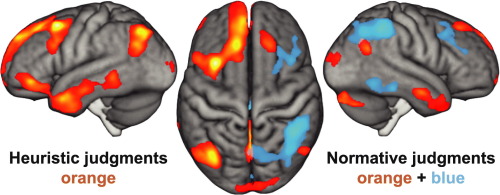Our official English website, www.x-mol.net, welcomes your feedback! (Note: you will need to create a separate account there.)
Neurocognitive processes underlying heuristic and normative probability judgments.
Cognition ( IF 4.011 ) Pub Date : 2019-12-12 , DOI: 10.1016/j.cognition.2019.104153 Linus Andersson 1 , Johan Eriksson 2 , Sara Stillesjö 3 , Peter Juslin 4 , Lars Nyberg 5 , Linnea Karlsson Wirebring 3
Cognition ( IF 4.011 ) Pub Date : 2019-12-12 , DOI: 10.1016/j.cognition.2019.104153 Linus Andersson 1 , Johan Eriksson 2 , Sara Stillesjö 3 , Peter Juslin 4 , Lars Nyberg 5 , Linnea Karlsson Wirebring 3
Affiliation

|
Judging two events in combination (A&B) as more probable than one of the events (A) is known as a conjunction fallacy. According to dual-process explanations of human judgment and decision making, the fallacy is due to the application of a heuristic, associative cognitive process. Avoiding the fallacy has been suggested to require the recruitment of a separate process that can apply normative rules. We investigated these assumptions using functional magnetic resonance imaging (fMRI) during conjunction tasks. Judgments, whether correct or not, engaged a network of brain regions identical to that engaged during similarity judgments. Avoidance of the conjunction fallacy additionally, and uniquely, involved a fronto-parietal network previously linked to supervisory, analytic control processes. The results lend credibility to the idea that incorrect probability judgments are the result of a representativeness heuristic that requires additional neurocognitive resources to avoid.
中文翻译:

启发式和规范性概率判断基础的神经认知过程。
将组合事件(A&B)中的两个事件判断为比其中一个事件(A)更可能被称为合取谬误。根据对人类判断和决策的双重过程解释,谬误是由于启发式,联想式认知过程的应用所致。有人建议,要避免谬误,就必须招募一个可以应用规范性规则的独立程序。我们在任务执行期间使用功能磁共振成像(fMRI)研究了这些假设。判断是否正确,都涉及与相似判断中相同的大脑区域网络。另外,唯一避免合取谬误涉及先前与监管,分析控制过程相关联的额顶网络。
更新日期:2019-12-13
中文翻译:

启发式和规范性概率判断基础的神经认知过程。
将组合事件(A&B)中的两个事件判断为比其中一个事件(A)更可能被称为合取谬误。根据对人类判断和决策的双重过程解释,谬误是由于启发式,联想式认知过程的应用所致。有人建议,要避免谬误,就必须招募一个可以应用规范性规则的独立程序。我们在任务执行期间使用功能磁共振成像(fMRI)研究了这些假设。判断是否正确,都涉及与相似判断中相同的大脑区域网络。另外,唯一避免合取谬误涉及先前与监管,分析控制过程相关联的额顶网络。



























 京公网安备 11010802027423号
京公网安备 11010802027423号